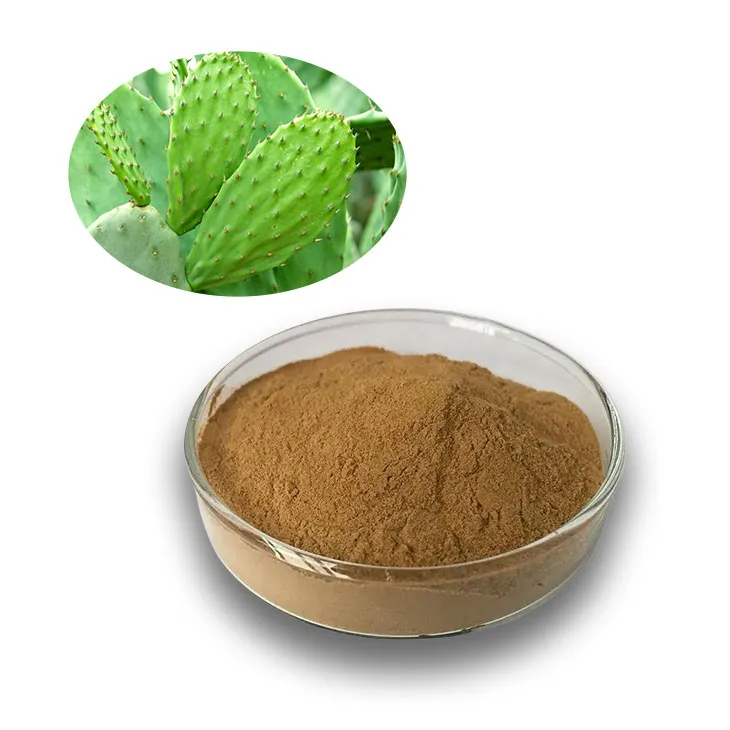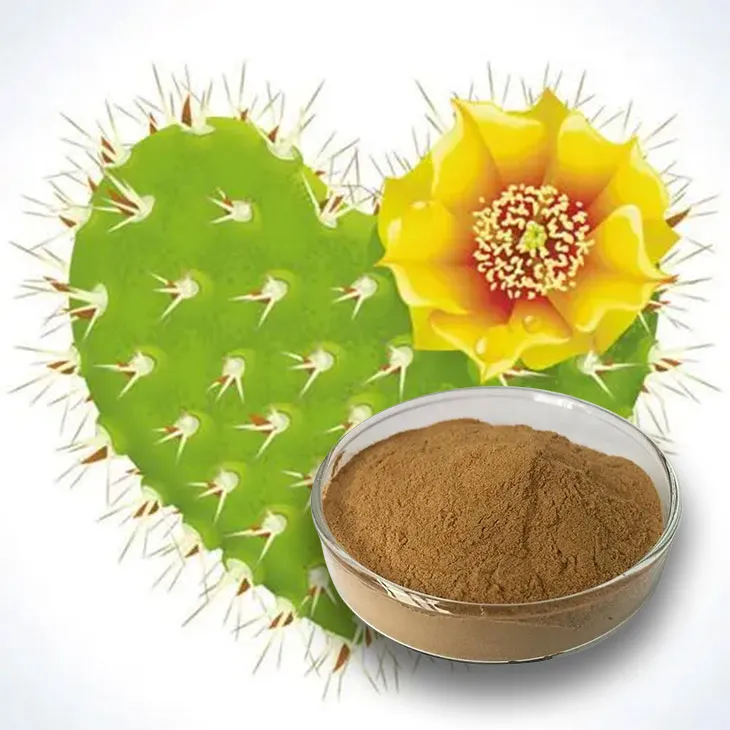- 0086-571-85302990
- sales@greenskybio.com
Components of cactus extract in fertilizers and feeds.
2024-11-26

1. Introduction
Cactus is a unique plant with a variety of properties that make its extract useful in both fertilizers and feeds. The use of Cactus Extract in these areas has been an area of increasing interest due to its potential benefits for plants and animals alike. This article will explore the components of Cactus Extract in fertilizers and feeds, highlighting their importance and functions.

2. Cactus Extract in Fertilizers
2.1 Trace Elements
Cactus extract is a valuable source of trace elements in fertilizers. These trace elements are crucial for plant metabolism. For example, iron (Fe) is an important component in the synthesis of chlorophyll. Without sufficient iron, plants may develop chlorosis, which can significantly affect their growth and productivity. Manganese (Mn) is also present in cactus extract. It plays a role in enzyme activation, which is necessary for various metabolic processes in plants. Zinc (Zn) is another trace element found in cactus extract. It is involved in the synthesis of growth hormones in plants, such as auxins. These hormones regulate plant growth, cell division, and differentiation.
- The presence of these trace elements in cactus extract can help improve soil fertility. When added to the soil as part of a fertilizer, the trace elements are made available to plants, which can then absorb and utilize them for their growth and development.
- Cactus extract can also act as a supplement to traditional fertilizers. In some cases, soils may be deficient in certain trace elements. By adding cactus extract, farmers can ensure that plants receive all the necessary nutrients for optimal growth.
2.2 Bio - Compounds and Plant Resistance
The bio - compounds in cactus extract play an important role in improving plant resistance. These compounds can enhance the plant's ability to withstand various environmental stresses. For instance, some bio - compounds may act as antioxidants. In plants, antioxidants help protect cells from damage caused by reactive oxygen species (ROS). ROS are produced during normal plant metabolism, but their levels can increase under stress conditions such as drought, high temperature, or pathogen attack.
- By scavenging ROS, the antioxidants in cactus extract can prevent oxidative damage to plant cells. This can lead to improved plant health and survival under stressful conditions.
- Other bio - compounds in cactus extract may be involved in the plant's defense response against pathogens. They can stimulate the production of defense - related proteins and chemicals in plants, which can help the plant fend off diseases.

3. Cactus Extract in Feeds
3.1 Energy - Rich Substances
Cactus extract provides a natural source of energy - rich substances in feeds. These substances can be a valuable source of nutrition for animals. One of the main energy - rich components in cactus extract is carbohydrates. Carbohydrates are broken down by animals during digestion to release energy. This energy is then used for various physiological processes, such as muscle movement, growth, and reproduction.
- For livestock such as cattle and sheep, cactus extract can be an alternative source of energy, especially in areas where traditional feed sources may be limited. It can help meet the energy requirements of animals, ensuring their proper growth and development.
- The carbohydrates in cactus extract may also have a prebiotic effect. They can promote the growth of beneficial gut bacteria in animals. These bacteria play an important role in digestion, nutrient absorption, and immune function.
3.2 Bio - Compounds and Animal Stress Tolerance
Similar to its role in plants, the bio - compounds in cactus extract can enhance animal stress tolerance. Animals are often exposed to various stressors in their environment, such as changes in temperature, diet, or exposure to pathogens. The bio - compounds in cactus extract can help animals cope with these stressors.
- Some bio - compounds may have anti - inflammatory properties. Inflammation can occur in animals in response to stress or injury. By reducing inflammation, these bio - compounds can help improve the overall health and well - being of animals.
- Other bio - compounds may modulate the animal's immune system. A well - functioning immune system is essential for animals to resist diseases. The bio - compounds in cactus extract can help boost the immune system, enabling animals to better defend themselves against pathogens.

4. Conclusion
In conclusion, cactus extract contains a variety of components that are beneficial for both fertilizers and feeds. In fertilizers, the trace elements and bio - compounds can improve plant metabolism and resistance. In feeds, the energy - rich substances and bio - compounds can enhance animal nutrition and stress tolerance. The use of cactus extract in these applications has the potential to contribute to more sustainable agriculture and animal husbandry. However, further research is still needed to fully understand the mechanisms of action of cactus extract components and to optimize their use in fertilizers and feeds.
FAQ:
What are the main trace elements in cactus extract for fertilizers?
Cactus extract for fertilizers may contain elements like iron, manganese, zinc, and copper. These trace elements play important roles in various aspects of plant metabolism, such as enzyme activation and chlorophyll synthesis.
How do the energy - rich substances in cactus extract for feeds benefit animals?
The energy - rich substances in cactus extract can be a valuable source of nutrition for animals. They can be broken down during digestion to release energy, which is essential for growth, reproduction, and maintaining normal physiological functions.
What specific bio - compounds in cactus extract improve plant resistance in fertilizers?
Some bio - compounds in cactus extract, such as flavonoids and phenolic acids, can enhance plant resistance. They may act as antioxidants, protecting plants from oxidative stress, or they can induce the plant's defense mechanisms against pests and diseases.
How does cactus extract in feeds enhance animal stress tolerance?
The bio - compounds in cactus extract can modulate the animal's physiological responses to stress. For example, they may help regulate the animal's immune system, improve its antioxidant capacity, or affect hormonal balance, all of which contribute to enhanced stress tolerance.
Are there any potential drawbacks to using cactus extract in fertilizers and feeds?
One potential drawback could be the presence of certain compounds that may be toxic in large amounts. Also, the extraction process needs to be carefully controlled to ensure consistency in the quality of the extract. In addition, there may be issues related to cost - effectiveness and availability of large - scale production.
Related literature
- The Composition and Application of Cactus Extract in Agricultural Products"
- "Bioactive Compounds in Cactus Extract: Implications for Fertilizer and Feed Additives"
- "Cactus Extract: A Promising Ingredient in Modern Fertilizers and Feeds"
- ▶ Hesperidin
- ▶ Citrus Bioflavonoids
- ▶ Plant Extract
- ▶ lycopene
- ▶ Diosmin
- ▶ Grape seed extract
- ▶ Sea buckthorn Juice Powder
- ▶ Fruit Juice Powder
- ▶ Hops Extract
- ▶ Artichoke Extract
- ▶ Mushroom extract
- ▶ Astaxanthin
- ▶ Green Tea Extract
- ▶ Curcumin
- ▶ Horse Chestnut Extract
- ▶ Other Product
- ▶ Boswellia Serrata Extract
- ▶ Resveratrol
- ▶ Marigold Extract
- ▶ Grape Leaf Extract
- ▶ New Product
- ▶ Aminolevulinic acid
- ▶ Cranberry Extract
- ▶ Red Yeast Rice
- ▶ Red Wine Extract
-
Cat Claw Extract
2024-11-26
-
Citrus Aurantii Extract
2024-11-26
-
Tormentil Extract
2024-11-26
-
Ivy Extract
2024-11-26
-
Lotus leaf extract
2024-11-26
-
Carrageenan Extract Powder
2024-11-26
-
Boswellia Serrata Extract
2024-11-26
-
Aminolevulinic acid
2024-11-26
-
Acerola Extract
2024-11-26
-
Bayberry Extract
2024-11-26





















